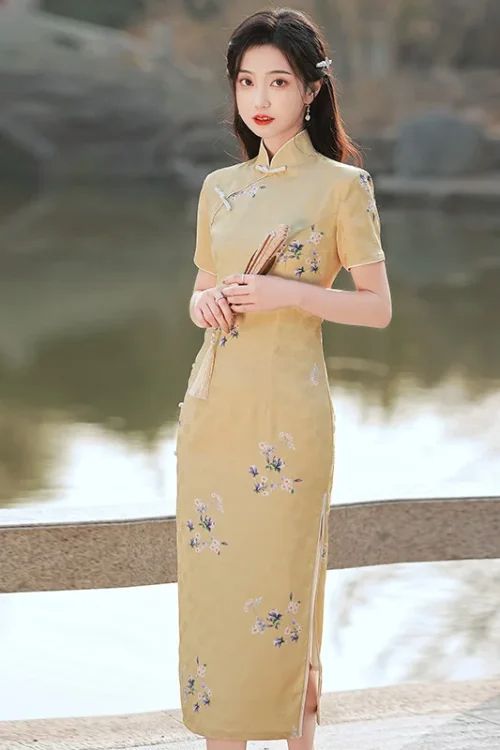The Qipao‘s Cultural Significance: A Reflection of Chinese Identity
The qipao, an iconic Chinese dress, transcends its mere function as a garment. It embodies a profound cultural significance, reflecting the multifaceted identity of China.

Historical Origins
The qipao’s origins can be traced back to the Manchu dynasty, where it was worn by women of the ruling class. Over time, it evolved into a symbol of Chinese femininity and elegance. Its form-fitting silhouette, high neckline, and intricate embroidery evoke a sense of grace and sophistication.
Symbol of Resilience
The qipao’s symbolism extends beyond its aesthetic appeal. It represents the resilience and adaptability of Chinese culture. Despite foreign influences and changing societal norms, the qipao has endured as a timeless symbol of Chinese identity. It has been worn by generations of women, from traditionalists to modern feminists, each imbuing it with their own unique interpretation.
Versatility and Adaptability
The qipao’s versatility is another testament to its cultural significance. It can be tailored to suit various occasions, from formal events to casual gatherings. Its adaptability reflects the diverse nature of Chinese society, where tradition and modernity coexist harmoniously.
Cultural Pride
Furthermore, the qipao has become a symbol of Chinese cultural pride. It is often worn by Chinese people living abroad as a way to connect with their heritage. Its presence in international fashion shows and cultural events showcases the growing global recognition of Chinese culture.
Conclusion
In conclusion, the qipao is more than just a dress. It is a living embodiment of Chinese identity, reflecting the country’s rich history, cultural resilience, and global influence. Its symbolism transcends its physical form, becoming a powerful representation of the Chinese people and their enduring spirit.
The Qipao as a Symbol of Female Empowerment: Breaking Gender Norms
The qipao, an iconic Chinese dress, transcends its mere function as a garment. It embodies a rich tapestry of cultural and historical significance, particularly in the realm of female empowerment.

Transformation of Symbolism
Traditionally, the qipao was a symbol of female modesty and propriety. Its high neckline, long sleeves, and form-fitting silhouette adhered to Confucian ideals of feminine virtue. However, in the early 20th century, the qipao underwent a transformation.
Modernity and Liberation
As China embraced Western influences, the qipao evolved into a symbol of modernity and liberation. Women began to wear it in public spaces, challenging traditional gender roles. The qipao’s close-fitting design accentuated the female form, empowering women to express their sexuality and defy societal expectations.
National Pride
Moreover, the qipao became a symbol of national pride. During the Chinese Revolution, women wore qipaos as a sign of solidarity and resistance against foreign oppression. The dress represented their determination to fight for their rights and contribute to the nation’s progress.
Contemporary Significance
In contemporary times, the qipao continues to be a powerful symbol of female empowerment. It has been embraced by feminists and activists as a way to reclaim their bodies and challenge patriarchal norms. The qipao’s versatility allows it to be adapted to various contexts, from formal occasions to everyday wear.
Global Recognition
Furthermore, the qipao has gained international recognition as a symbol of Chinese culture. It has been featured in countless films, television shows, and fashion magazines, showcasing its enduring appeal and cultural significance.
Conclusion
In conclusion, the qipao is more than just a dress. It is a symbol of female empowerment, breaking gender norms, and representing national pride. Its evolution over time reflects the changing roles and aspirations of women in Chinese society. Today, the qipao continues to inspire and empower women around the world, serving as a reminder of their strength, resilience, and the power of self-expression.
The Qipao’s Evolution: From Traditional Garb to Modern Fashion Statement
The qipao, an iconic Chinese dress, transcends its mere function as a garment. It embodies a rich tapestry of cultural and historical significance, serving as a symbol of national identity, feminine allure, and social change.

Historical Development
Originating in the early 20th century, the qipao emerged as a fusion of traditional Manchu attire and Western influences. Its form-fitting silhouette, high neckline, and side slits exuded an air of both elegance and modernity. As China underwent political and social transformations, the qipao evolved alongside the nation, becoming a symbol of national pride and cultural revival.
Popularity in the Republican Era
During the Republican era, the qipao gained widespread popularity among women of all social classes. It represented a break from the restrictive clothing norms of the past, empowering women with a sense of freedom and self-expression. The qipao’s popularity extended beyond China’s borders, captivating the imaginations of Western designers and fashion enthusiasts.
Post-War Resurgence
In the post-World War II era, the qipao underwent a resurgence as a symbol of Chinese heritage and cultural identity. It became a staple of traditional festivals and cultural events, evoking a sense of nostalgia and connection to the past. However, the qipao’s significance extended beyond its traditional roots.
Contemporary Fashion Statement
In the 1990s, the qipao experienced a revival as a fashion statement. Contemporary designers reinterpreted the classic silhouette, incorporating modern fabrics, bold colors, and innovative designs. The qipao became a symbol of cultural fusion, blending traditional elements with contemporary aesthetics.
Ongoing Evolution
Today, the qipao continues to evolve, reflecting the changing social and cultural landscape of China. It remains a symbol of national pride, feminine empowerment, and cultural heritage. Whether worn in its traditional form or reimagined by modern designers, the qipao embodies the enduring spirit of Chinese culture, bridging the past and the present.
Conclusion
In conclusion, the qipao is more than just a dress. It is a symbol of cultural identity, social change, and feminine allure. Its evolution from traditional garb to modern fashion statement reflects the dynamic nature of Chinese society and the enduring power of cultural heritage. As the qipao continues to evolve, it will undoubtedly remain a cherished symbol of China’s rich and vibrant culture.
